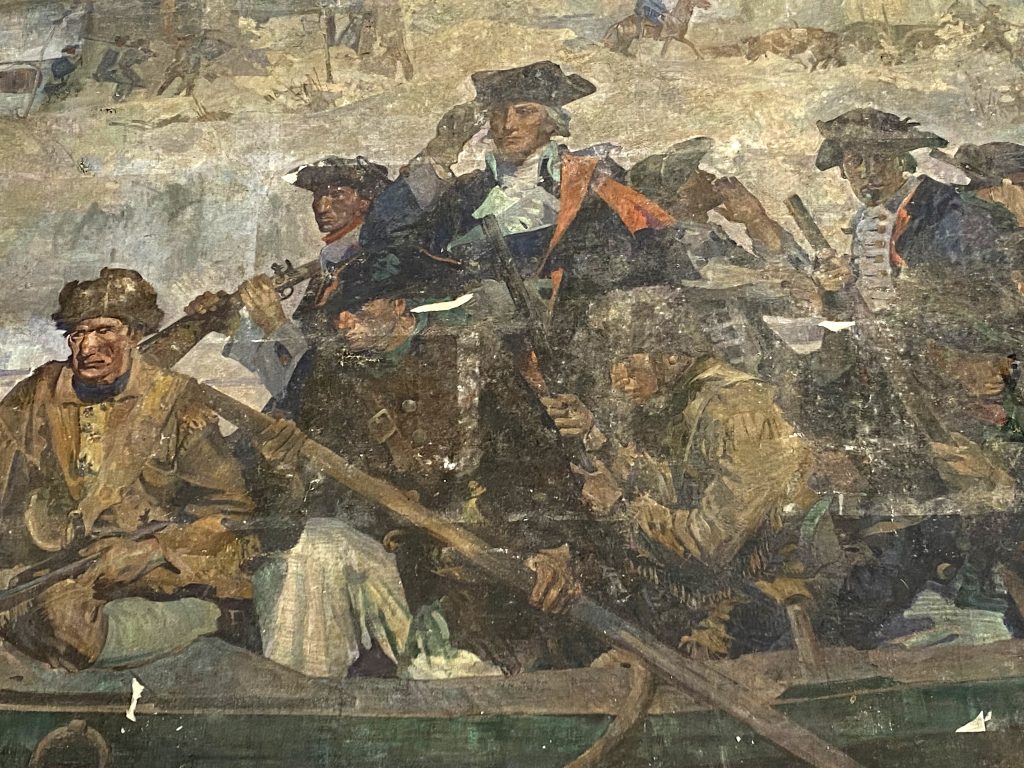
Restoring the (other) artwork of Washington crossing the Delaware
Money is being raised to restore a 1921 mural of Washington's crossing for the nation’s 250th birthday in three years.
| March 15, 2023
While looking into the history of Washington Crossing Historic Park for a book she was working on, Pat Millen discovered plans to move a mural of Washington crossing the Delaware into the park’s visitors center and museum in time for the nation’s bicentennial.
“That leapt off the page at me because I worked there in 1976,” Millen said. “I don’t remember that the mural ever made it to the park. Where is it? And that started the search.”
Park records from the time mentioned moving the mural from storage in Skylands Manor at Ringwood State Park, in Ringwood, N.J., where the mural, painted by the American artist George Matthews Harding, had been in storage for half a century.
Millen, a former trustee of the Washington Crossing Park Association, passed along the information she had gathered to the current administration of the association.
“Pat Millen sent me an email saying she had come across this painting and asked if I thought that the park association would be interested in doing anything about it,” said the association’s executive director, Annette Earling. “I leapt off my chair and said absolutely. I think this is so exciting.”
Harding’s mural is not to be confused with a more famous painting of the same topic, Emmanual Leutze’s “Washington Crossing the Delaware,” currently on display at the Metropolitan Museum of Art. (Though more famous, Leutze’s painting from 1851 does contain at least one notable historical inaccuracy: It depicts a soldier holding a flag that did not exist at the time of Washington’s crossing.)
Both artworks depict the historic event that Washington Crossing Park, in Titusville, N.J., was created to memorialize.
In the middle of a cold night in December 1776, George Washington and his men crossed the Delaware River from Pennsylvania into New Jersey, launching a successful surprise attack on British forces stationed there. The victory reinvigorated flagging American morale.
While plans to bring Harding’s mural to Washington Crossing Park for the bicentennial in 1976 fell through, it will make it there for the nation’s 250th birthday in three years.
The association has plans to move the mural, which belongs to the state of New Jersey, into the new visitors center and museum under construction at Washington Crossing Park, which is scheduled for completion by 2026.

The WCPA is looking to raise $60,000 through donations to have the mural restored and framed. Once that goal is met, Christyl Cusworth, the project’s conservationist, will begin restoring the 15.5-foot-by-10-foot piece. That work is expected to take two and a half months.
Where the restored mural will wait until the completion of the park’s new visitors center and museum is currently undecided. “Either it will go into storage, or we’ll find a place that can safely display it between now and then,” Earling said.
The mural of oil paint was commissioned in 1921 for the Taylor Opera House in Trenton, N.J.
When the opera house was set to be demolished in 1969, the painting was in danger of being destroyed along with the building. When the painting was removed from the opera house in Trenton, it was moved to storage in Skylands Manor, which belongs to the State of New Jersey.
A New York Times article from 1972 recounted how the American Association of Conservators and Restorers worked to extricate the painting from the wall of the opera house and preserve it until it could be displayed elsewhere.
In addition to its subject matter, Millen’s research found that the mural has another interesting connection to Washington Crossing Park.
Millen said the opera house was where “one of the first large public meetings was held with Trenton dignitaries and people from Pennsylvania to determine the beginnings of the state parks on both sides of the river.”
Having seen Harding’s mural as well as Leutze’s “Washington Crossing the Delaware,” Earling has an appreciation for both pieces, but notes that they capture very different emotions.
“About two weeks ago, I went to the Met to see the Leutze crossing painting, which is stunning. It’s a very majestic piece. It’s meant to evoke these strong emotions, about liberty and about passion for your nation,” Earling said.
Harding was born in Philadelphia, and studied at the Philadelphia Academy of Fine Arts. He was employed by the U.S. military during World War I and World War II as a war artist, and he focused on depicting military technology and scenes of war.
“This is a different type of piece,” Earling said of his mural. “It’s gritty, it’s dynamic. It’s much more historically accurate and it’s home. I live on the Delaware River, and Harding was a Philadelphia boy, he was painting contours where this actually happened.”







